Stay informed

Stay informed


Clarity with Smarter Contact Lens Care Every year on May 5th, World Hand Hygiene...

Clarity with Smarter Contact Lens Care Every year on May 5th, World Hand Hygiene...

Clarity with Smarter Contact Lens Care Every year on May 5th, World Hand Hygiene...

Clarity with Smarter Contact Lens Care Every year on May 5th, World Hand Hygiene...

Ever put on a pair of 3D glasses at the movies and wondered how a flat screen suddenly gains depth? It’s not magic—it’s science, and the process highlights just how clever our eyes and brain really are…
English inventor William Friese-Greene publicly exhibited the first three-dimensional anaglyphic motion pictures in 1893 during his Stereoscopic Cinematography Experiment in London. His system used two side-by-side screens and a stereoscope headset to merge images in the viewer’s eye, but the concept was too far ahead of its time for audiences.
Los Angeles audiences finally experienced the first commercial 3D film screening in 1922 with The Power of Love. This film employed red-and-green anaglyph technology to create depth and even allow viewers the choice between two alternate endings by looking through either lens on its own.
The 1950s brought 3D’s first real boom, led by Bwana Devil (1952), before it experienced another wave of popularity in the late 70s and 80s. Most recently, technological breakthroughs in the early 2000s prompted a resurgence of 3D cinema, notably including James Cameron’s Avatar (2009).
From clunky stereoscopes to coloured glasses and finally today’s polarised and digital systems, filmmakers and innovators have steadily refined the 3D experience.
Depth perception relies on the small space between our eyes which provides each with a slightly different perspective. Our brain merges these two views into one unified image and uses the difference (the binocular disparity) to gauge three-dimensional space.
3D films take advantage of this by projecting two slightly offset versions of the same image at once. The role of 3D glasses is to make sure each eye is shown only one of those layers, and the brain fuses them into a single image with a calculated depth – a process called stereoscopy.
Anaglyph glasses are the classic 3D eyewear, instantly recognisable by their red and cyan lenses which act as a filter for the layered images you’re viewing on screen. Each lens allows only its counterpart image through – one blocking the red while the other blocks cyan – and your brain merges the two images into one, creating depth. Unfortunately, this results in a distortion of the colour quality.
Today, most cinemas use grey-lens polarised glasses which work by filtering light waves and allow for a more natural colour quality. The movie is projected using two synchronised projectors each with its own polarisation filter set at perpendicular angles. The glasses’ lenses are aligned to match these filters, ensuring each eye only receives its designated image. Once again, the brain does the work of combining them into a single, 3D picture.
The most advanced option today is the active shutter system, often used in gaming and home theatres for an impressive full-colour, high-definition 3D effect. Instead of filters, these glasses use LCD technology to darken the lenses in rapid sequence while the synchronised screen shows alternate frames for each eye.
3D glasses replicate how most people’s eyes naturally process depth. But for some, conditions like reduced vision in one eye or poor binocular coordination can greatly impact the experience.
This is where an eye test can help. In a comprehensive eye exam, your optometrist can assess how well your eyes work together, as well as other important aspects of overall eye health such as depth perception, eye alignment and visual fields.
At Island Optical, independent optometrists provide in-store eye tests for adults and children. If it’s been a while, or you’ve noticed any changes to your vision, schedule an appointment today so you can continue seeing the world with full three-dimensional clarity!
Your brain and eyes are an incredible duo! They let you enjoy the immersive world of 3D films as well as the real, living world around you in sharp detail. Preserving this is important, which is why regular routine eye tests are essential for people of all ages.
Whether you need prescription glasses, polarised sunglasses or contact lenses, our expert team at Island Optical is here to assist. Tenant optometrists provide comprehensive eye tests on-site at our Hobart and Launceston locations, most of which are bulk billed for eligible Medicare cardholders.
Book an appointment online today and ensure your eyes are ready for the next blockbuster in crisp, clear 3D.
Subscribe now to receive latest exclusive news and updates
Island Optical acknowledges the traditional Owners and Custodians of the land on which our stores stand. We pay our respect to Indigenous Elders past, present and emerging.



This is a confirmation that Facial Images recorded are now deleted.